Realizamos un estudio retrospectivo de las tentativas y suicidios que se produjeron por ingestión de fármacos durante el año 1998 en el Área Sanitaria de Santiago de Compostela.
Ocurrieron un total de 167 casos, lo que representa una incidencia de 35,3/100.000 habitantes y el 0,2% de los motivos de consulta en el servicio de urgencias. La mayoría eran mujeres, 122 (73%), y la edad media fue de 29,7 años.
Los fármacos implicados más frecuentemente, tanto mediante sospecha clínica como con la confirmación toxicológica, fueron las benzodiacepinas y a continuación los antidepresivos, pero son éstos últimos los que originan la mayor parte de los ingresos en la unidad de cuidados intensivos.
En casi un cuarto de los análisis (24,5%) se encontraron varios tóxicos implicados, siendo la asociación más frecuente la de alcohol con benzodiacepinas.
Sólo se produjeron dos muertes, una de ellas por digoxina durante su atención en urgencias, y la otra por antidepresivos tras haber ingresado en la unidad de cuidados intensivos.
We carried out a retrospective study of suicides and suicide attemps by therapeutic drug ingestion during the year 1998 in the area of Santiago de Compostela.
There were reported of 167 cases, wich represent an incidence of 35,3/100.000 inhabitants and the 0.2% of the total admissions through the emergency room during that time. The most part of them were women, 122 (73%) and the average age was 29.7 years.
The therapeutic drug used most frequently, by clinical characteristics and also drug screening confirmation were the benzodiazepines and in second place the antidepressants although the antidepressants were the cause of the most part of the admissions to intensive care unit.
In almost a quarter of screening (24.5%) was the found several toxics implicated, being the most frequent combination alcohol and benzodiazepines.
Only two deaths were recorded, one of them caused by digoxine in the emergency room, and the other one by antidepressants after being admitted in the intensive care unit






